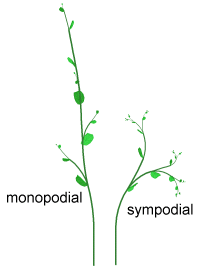Meristem parameters
The parameters in the Meristems section determine how meristems199WIB8 work, and therefore how the plant branches and develops.
Axillary meristem and leaf arrangement
Plants are often classified by how many leaves they have at each node – one (alternate), two (opposite), or more than two (whorled). PlantStudio simulates the first two cases, which cover most plants. Which of these arrangements you choose determines how many axillary meristems are available for branching and for producing inflorescences, because axillary meristems form in the angles between leaf and stem (axils). So a plant with an opposite leaf arrangement has twice as many axillary meristems as a plant with an alternate leaf arrangement.
Meristem 3D object, scale, rotations, colors
These parameters determine how meristems appear on the plant. Normally you will not want to see meristems, so you will keep the Meristems: Meristem 3D object scale at full size parameter set to zero. But if you want to see how the meristems work, or if you are making some plant on which little buds would look right, you can increase the scale.
Branching index, Apical dominance strength, Secondary branching
Branching in PlantStudio works in this way: Each day, each axillary meristem that is not already committed to reproductive growth ponders whether it might start a new branch. In making this decision the meristem takes three things into account.
▪ First, the meristem considers the branching index for the whole plant, which runs from zero to one hundred. This gives the meristem a probabilistic limit to check – if it draws a random number between zero and one hundred and the number falls below the branching index, the meristem can create a branch.
▪ Second, the meristem may lower the branching index it uses based on its proximity to an apical meristem. One of the ways plants control their shape is by apical dominance. In apical dominance the apical meristem at the end of the plant stem dominates the other meristems by sending out a substance that inhibits them from branching. (This is why garden books tell you to “top” plants you want to grow branches – you are removing the apical meristem.) PlantStudio simulates apical dominance by reducing the probability of branching in meristems close to the stem apex. You can control where the apical dominance effect starts by setting the parameter Meristems: Apical dominance strength (as node distance). For example, if a plant stem has five nodes and you set the apical dominance strength to 3.0, the first two nodes will branch normally but the last three (closest to the apical meristem) will face an increasing difficulty in branching.
▪ Finally, the meristem may be prevented from branching if you have turned off secondary branching and it is not on the plant’s main stem.
Usually you will want to keep the branching index at less than 30%, because above that percentage there can be so much branching that the plant takes a very long time to draw. You can also control the amount of branching by changing how many axillary meristems are available to contemplate branching. You can reduce the number of axillary meristems by choosing alternate leaf arrangement and by increasing the minimum days needed to create new internodes and leaves.
Sympodial branching
Most plants have monopodial branching, in which apical meristems extend stems and axillary meristems create new branches. In sympodial branching, each apical meristem dies off after it has made one internode, and one of the axillary meristems it created takes over the main stem. You can see this type of branching in tomato plants. To specify sympodial branching, just turn this parameter on. Note that when you choose sympodial branching, changing the Branching index parameter will have no effect unless you choose “opposite” for the parameter Axillary meristem and leaf arrangement (because all the axillary buds are used up).

Branching angle
The branching angle parameter determines what angle new branches make with the stems they developed out of. Because PlantStudio doesn’t have a gravity model, setting this parameter to a large angle may mean that you get branches at impossible angles. So it is best to keep the angle below 90 degrees unless you have little branching or disallow secondary branching.
Probability each meristem will become reproductive when gets flowering signal
This parameter is also called the determinate probability. When determinate plants begin reproduction, they go all out and never grow vegetatively again. Indeterminate plants, on the other hand, still grow vegetatively though most of their resources go to reproduction. You may have seen this distinction among tomato varieties: bush varieties tend to be determinate (they grow, then flower, then die), while vine varieties are usually indeterminate (they grow, then flower and grow, then flower and grow some more, and they may be kept alive and growing for a long time in a controlled environment). PlantStudio simulates that difference here using a determinate probability, which is the probability that any one meristem will switch over to reproduction when the plant enters its reproductive phase. A determinate probability of one means that the plant makes no more vegetative parts. A determinate probability of zero means the plant will never flower. A determinate probability of 0.5 means that about half the meristems will switch over and half will keep growing vegetatively.
Created with the Personal Edition of HelpNDoc: Easily create CHM Help documents